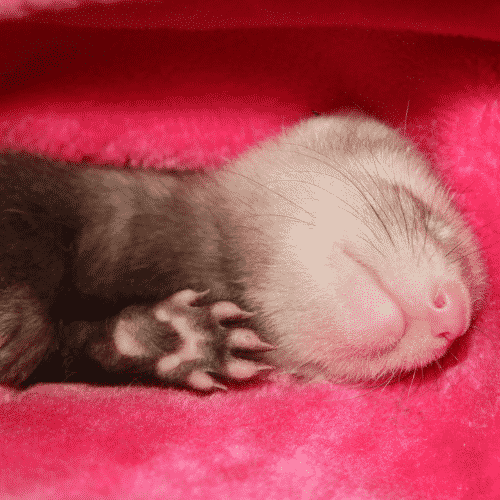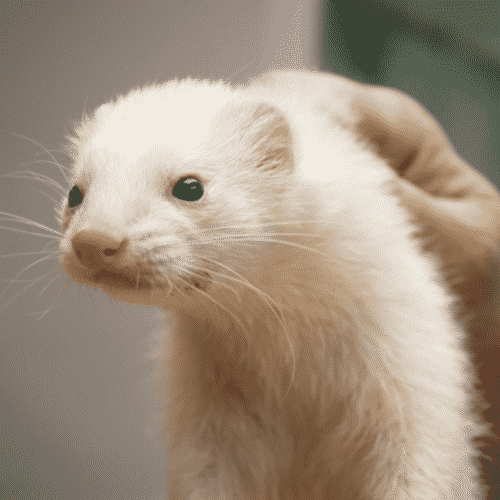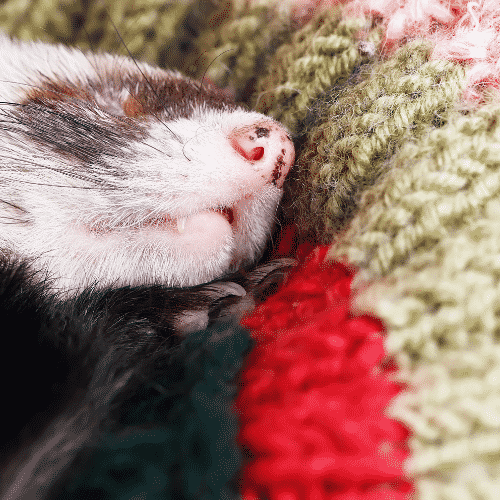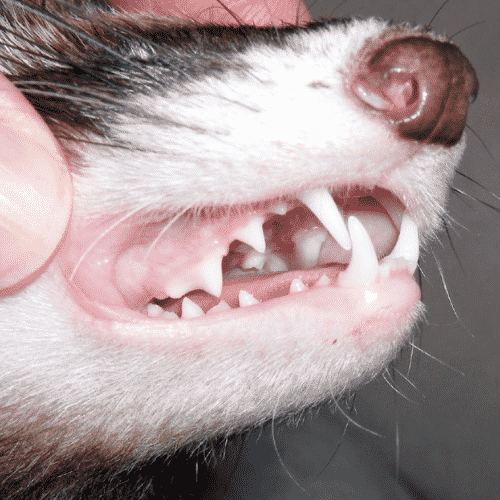Some of the changes ferrets go through as they become older are similar to the ones that people go through as they get older. Changes to the physical structure of the body, as well as changes in appetite, mobility and personality, and temperament, are among the effects of hair loss, hair thinning, and tooth decay. Healthy ferrets, not sick ferrets, are the focus of this article’s discussion.

Ferret Age Calculator
Because a ferret’s growth and physiological changes during its life are considerably different from those seen in humans, there is no foolproof mathematical formula for calculating a ferret’s human age.
A correlation table (age chart) based on observations of the ferret’s age has been produced by veterinarians to see a human age equivalent:
The lifespan of a ferret is quite variable and is dependent on both its way of life (food, rut, brightness of its surroundings) and its origin (origin). Between five and fourteen years is considered the average life expectancy of a ferret.
Ferret Age Stages & What to Expect
Physical Structure
Ferret babies (kits) are born weighing 10 to 12 grams with eyes and ears closed and are normally pink in body color. They start showing “peach fuzz” fur on Day 1 or 2 and have their baby hair at about 4 or 5 weeks of age. They are totally dependent upon their mother for survival. By 4 weeks of age, their weight is around 200 grams or 8 ounces, and they start to blindly investigate their surroundings. By week 5 or 6, they open their eyes and ears and start to explore everything they see. By 8 months of age, the ferret kit reaches its adult structure.

The average weight for a neutered, adult female ferret is around 1 pound 6 ounces; the average weight for a neutered, adult male ferret is 2 to 4 pounds. A hob (intact male) can mature to a weight of 5 or 6 pounds, and a jill (intact female) can reach about 2 pounds 6 ounces.
The first two years of a ferret’s life are its prime. The ferret’s physical structure should have strong bone density, good muscle tone, and a thick full coat. This is similar to the strong bone density, strength, and good muscular appearance of a 25-year-old person.
A ferret kit develops its adult teeth by 8 weeks of age. As they age, their teeth slowly become more and more opaque. The teeth also wear down. Plaque buildup and gum disease may occur, so brushing and cleaning the teeth is important to help maintain a healthy ferret, whether young or old.
Nipping and Chewing
Expect ferret kittens and puppies to be mouthy, too. Learning that rough play is not suitable for delicate human skin is learned through proper socialization.
By the time a ferret kit is six months old, it should have been well socialized and the nipping should have decreased as they learn. Ferrets need to be socialized properly, and this influences their entire lives. “Biter” is an unfortunate label given to many ferrets. The term “a biter” is often used to describe a dog that has been neglected or abused.
Almost anything ferrets can get their teeth on will be eaten by them. As adults, many kitties continue to crave something to gnaw on. Since ferret cage bedding and play toys can harbor harmful bacteria, ferret owners must inspect their pet’s bedding and play toys periodically.
As a rule, Kits love to gobble up anything that serves as a bedtime blanket or swaddling cloth. The swallowed bedding fragments could be the cause of the missing items. Ferrets enjoy chewing on things like plastic, rubber bands, and cloth, which can lead to blockages in their intestines.
Physical Mobility
Kits are naturally inquisitive, and everything is new to them as they open their eyes. The athleticism of each individual ferret varies greatly. A ferret kit’s mobility is facilitated by a high level of vigor and curiosity. Ferrets younger than a year old are typically either snoozing or running around like maniacs.
As ferrets age, they tend to become less mobile because of weakened muscles and weakened bones. With age, ferrets lose their drive to run, jump and climb as much, and as a result, they become less “bouncy.”
Digging and attempting to flee are two more components of mobility. For years, the determination of ferrets has been widely documented in the literature. They can get out of an open door in a fraction of a second. Despite the fact that younger ferrets tend to be more persistent, these features do not appear to change.
Understanding Waardenburg Syndrome In Ferrets – A Complete Guide
Behavior
Ferrets are normally neutered at 5 or 6 weeks of age and don’t show any signs of being unneutered. Physical and behavioral characteristics differ between intact and non-intact ferrets’ kits.
These kits tend to be more sturdy and hefty. Sexual behavior in intact male ferrets includes dragging another ferret by the scruff or engaging in mounting. They’re working out as a unit. At about 7 months of age, intact female ferrets begin breeding season and have a large vulva and a strong attraction to male ferrets. It’s not uncommon to see severe behavior from intact ferrets when they’re in a breeding season twice a year.

After neutering, late-alter ferrets develop the same as ferrets that were early-neutered, and the sexual activity is completely eradicated. A trip to the doctor is advised if an early-neuter kit exhibits some or all of the sexual behavior of an intact ferret.
Growing up in good health is the goal of every ferret kit. Until the age of 4, ferrets should be treated as fun and alert companions. However, as they grows older, his zest for life and sense of humor dim. Unless you have an extremely energetic 5- or 6-year-old ferret, you shouldn’t expect him to play for long periods of time as an adult. Ferrets can play for 30 minutes, then take a nap and get back up and play for another 30 minutes or so. As long as the ferret is attentive, energetic, and engaged throughout the time he is out and about, this is just normal.
It’s not uncommon for ferrets to miss the litter box as they become older. It is possible to help an elderly ferret maintain their health and get the additional fluids and nutrients they need by giving them a daily “ferret soup mixture” (a high-calorie, easily digestible diet). To ensure that senior ferrets can continue to eat their regular diet, it is necessary to modify it.
Ferrets age in a variety of ways. As they grow older, female ferrets become more laid-back while male ferrets become more mellow. We fall in love with them when they turn into the cuddly critters we crave.
Ferret Memory Span – UPDATED 2022 – How Smart Are Ferrets?
Coat Change
Ferrets shed their newborn coats and mature into their adult coats by the time they are one year old. In a typical year, a ferret will go through two coat changes. They have a short, silky coat in the summer and a longer, thicker coat in the fall. They shed their heavy, thick winter coats in the spring. Ferrets ingest shedding hair when they groom themselves, thus ferret owners must administer a hairball treatment at this time. A gastrointestinal obstruction caused by a hairball may necessitate urgent surgery.
A ferret’s winter coat is influenced by the temperature of its home. A ferret’s body may think it’s summer if the temperature in the house is too high, which prevents the winter coat from forming.
After a seasonal coat change, a ferret’s coat color and face markings may alter. A drastic shift in coat color might occur. This is a common occurrence, although not all ferrets go through it; the process can differ from ferret to ferret. How a dog’s coat looks and how often it sheds are both influenced by diet. Coat conditioning may be aided by the use of supplements.
The color pattern is another factor. They’ll always be known as albinos. Age causes a ferret’s roan or silver to soften and turn white. Graying appears most prominently on the hind legs of sables and black sables. Keep your hair dye in the drawer; ferrets are not bothered by becoming gray. Changes like these are to be expected and are part of life.
Proliferative Colitis In Ferrets – UPDATED 2022 – A Complete Guide
Nose Coloration
Throughout a ferret’s life, the color of its nose can serve as a user identifier for similar-colored ferrets. Unless there is a medical condition, a person’s nose will maintain the same color throughout its life.
If a ferret’s nose gets darker or lighter or develops or loses spots, you can still use the nose to identify it as a distinct individual. In spite of the fact that a ferret’s nose might lighten over time, it can also tell you if the animal is ill.
Old Ferret Losing Weight? Here’s What to Do
Typically, ferrets acquire weight in the winter and shed it in the summer to prepare for the colder months. It’s a common observation among ferret owners that older ferrets tend to be less active and less hungry. After 3 years of age, we’ve noticed that ferrets tend to keep their winter/summer weights and may not fluctuate much between the two seasons as they become older.
Personalities
Ferrets’ personalities can shift over time. Older ferrets might become grouchy and less social as they become older. It’s possible that they grow enamored with each other and are unable to be separated, in which case they develop a strong desire for and attachment to their closest playmates. Ferrets can acquire an allergy to other animals, their own cagemates, or even their owner as they get older.

When you try to add a fresh ferret kit to the group, this becomes clear. The activities of a young, rambunctious ferret might be irritating to older ferrets. Introducing a new, older ferret could be a challenge. Older ferrets are more resistant to change than younger ferrets.
Ferret Teeth Age Charts – Are They Accurate?
One of the most common ways to figure out how old your ferret is is through a dental exam. The proper inspection of your ferret’s teeth to ascertain its age is, as the name implies, done.
By the scruff of its neck, you should be able to see your ferret’s teeth.

Ask for help or take your ferret to the vet for a dental checkup if you’re not comfortable doing this on your own. The two long incisors in your ferret’s mouth need to be checked.
Ferret Age: 1 Year or Less
Teeth that are white, unstained, and smooth suggest that the ferret is no older than a year. There will be no evidence of tooth discoloration in ferrets of this age.
Ferret Age: 1 Year to 2.5 Years
At this age, if your ferret has teeth that are a shade of yellow, but also translucent, they are between one and two years old.
This discoloration is caused by a buildup of tartar on the teeth. It’s normal for your ferret’s teeth to become translucent when their enamel wears away.
Ferret Age: 2.5 Years to 4 Years
The teeth of a ferret between the ages of two and a half and four years will be yellow in color and more transparent.
Ferret Age: 4 Years and Above
When a ferret reaches the age of 4 to 6 years, its teeth and gums begin to become yellow. When a tooth is decayed, it will seem yellow or brown, and may even appear rotten. Although it appears decaying, it is actually fine. It is safe for your ferret and will not inflict any harm on it.
Your ferret’s mouth may also begin to shed a few little teeth. Because of the numerous years of use, the teeth may sometimes appear to be chipped. Whiter teeth indicate that the ferret is younger age. Translucent and yellowed fur is a sign of an older ferret.
Are Ferrets Affectionate? How Do Ferrets Show Affection?
The Bottom Line
Signs. Everywhere you look, you’ll find them. They provide us with a wealth of information, ranging from our current location to our abilities. We get directions from road signs, and we stay safe because of caution signals. The cues our ferrets offer us as we care for them help us traverse their lifespan as well. Ferret owners only need to learn how to read and interpret the signals.
Our ferrets’ bodies alter as they become older. You know they’re becoming old when they slow down, don’t play as much, and sleep more. As they near the end of their lives, they may begin to show various indicators. When it’s time to make end-of-life decisions for our ferrets, knowing what to look for and how to interpret the indications can assist.

Doctor of Veterinary Medicine (D.V.M.) at Nation Taiwan University,Master of Science (M.S.) in Biomedical Engineering at National Taiwan University of Science and Technology




